1. Red Rock Canyon
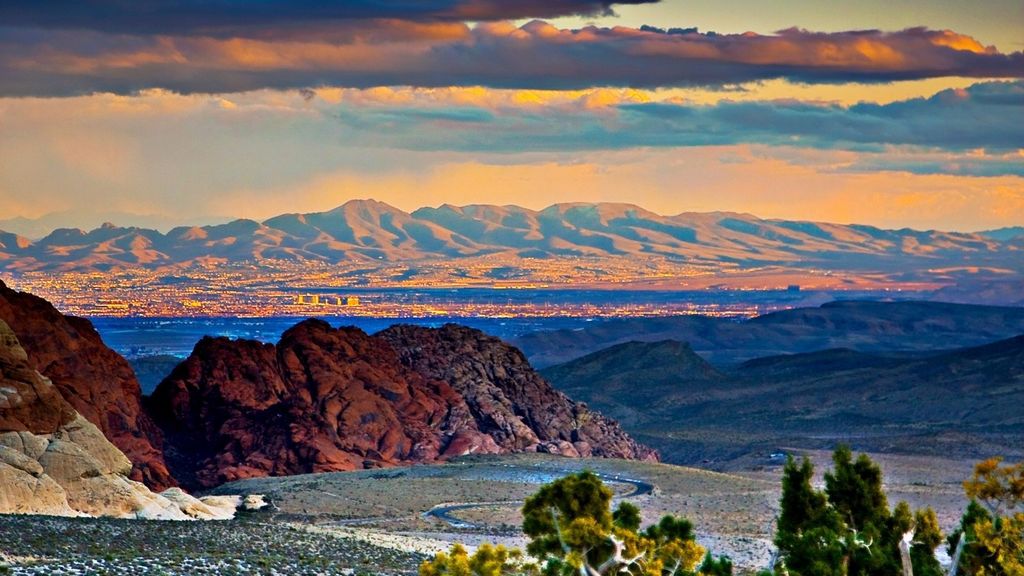
If you're looking for a quick road trip, the Red Rock Canyon National Conservation Area is only a few miles west of Las Vegas. You'll never run out of things to see and do in the Mojave Desert, which stretches nearly 196,000 acres.
A one-way 13-mile scenic drive, hiking and trails, plants and wildlife, geology, camping, cultural resources, and much more can be discovered in Red Rock Canyon. Whether you're in a car or on a bike, The Scenic Drive in Red Rock Canyon is a fantastic way to get a good overview of all the park has to offer. You'll drive past multiple picturesque viewpoints, a slew of trailheads, and some of Nevada's most breathtaking landscapes along the 13-mile trip. It's worth noting, though, that the Scenic Drive is a one-way road.
If you're up for a 13-mile bike ride, cycling the route is a lovely, relaxed way to take in the sights. Bicycles are permitted on the Scenic Drive, but not on the canyon trails.
Over 26 hiking trails crisscross the canyon, ranging in difficulty from easy strolls to strenuous uphill climbs, but all of them lead to amazing scenery, and one of Nevada’s most spectacular hikes can be found along the Calico Hills Trail, which takes in beautiful red bluffs and shady gorges.
Best time to visit: Summers in Red Rock can be extremely hot. You have to begin hiking at daybreak and finish by 10-11 a.m. You can hike all day and not pass out in the winter or spring which makes it the best time to visit! Don't forget to bring plenty of water with you.
Driving distance and time: The distance is just 23 miles, and it is only a 15 minutes drive from Las Vegas.
2. Valley of Fire
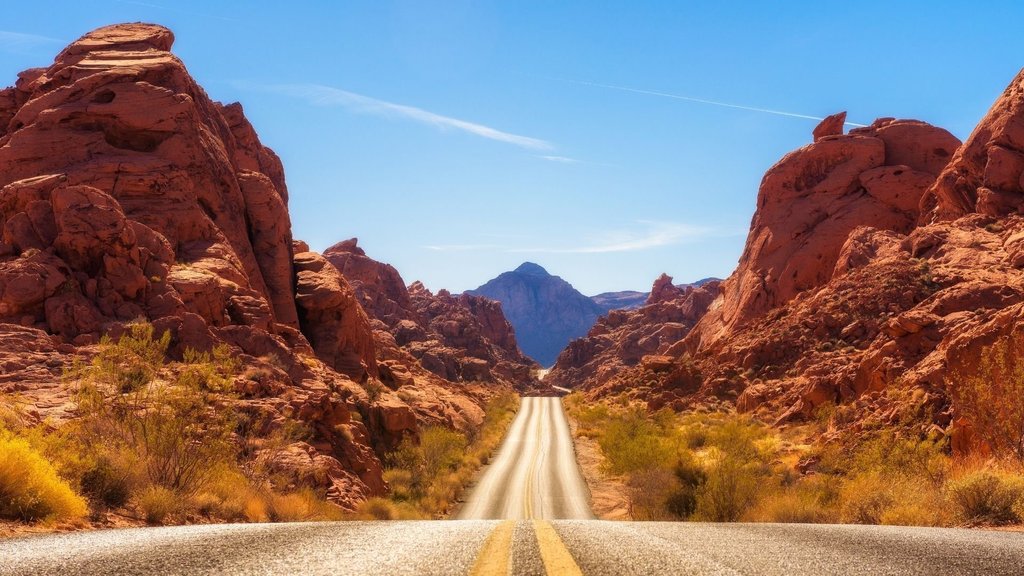
The Valley of Fire is a brilliant, red-hued landscape that is only an hour's drive from Las Vegas, making it an ideal day trip. Valley of Fire State Park is known throughout the world for its 40,000 acres of bright red Aztec sandstone outcrops nestled in grey and tan limestone. It also has ancient, petrified trees, petroglyphs, geological wonders, and even dinosaur bone. It's been dubbed "Mars" by filmmakers.
Many of the park's famous attractions are located along two main roads, so if you simply want to have a scenic drive around the park, you'll pass by many of them. We recommend going on a few walks in Valley of Fire State Park to really get to know the area. Because most of the trails aren't too long or challenging, completing some of Valley of Fire's top hikes in an afternoon is simple.
The Elephant Rock, which is well described by its name, is a gigantic rock formation that appears like an elephant gently walking across the rocky desert environment. It is the primary attraction of Valley of Fire State Park. Spend some time shooting Elephant Rock from different angles and heights while pondering how long erosion took to create this granite beauty and how long it will remain in its current state.
Because of its colorful sandstone vista, Fire Wave Trail is one of Valley of Fire State Park's most popular walks. This out-and-back trek begins by reaching Gibraltar Rock, a stunning outcropping that towers over the countryside.
Whatever the circumstance may be, Valley of Fire State Park is indeed an adventurer's paradise. A day pass costs $10 and gives you access to the entire park, allowing you to go hiking, rock climbing, or simply driving through beautiful scenery. It's just $20 for a tent or $30 for a full hook-up if you want to camp out and see the stars.
Best time to visit: The best time to visit Valley of Fire State Park is between October and April. During this period, the weather is pleasant without the scorching summer temperatures.
Driving distance and time: The driving distance is 49 miles, and it takes around an hour to get there from Las Vegas.
3. Hoover Dam
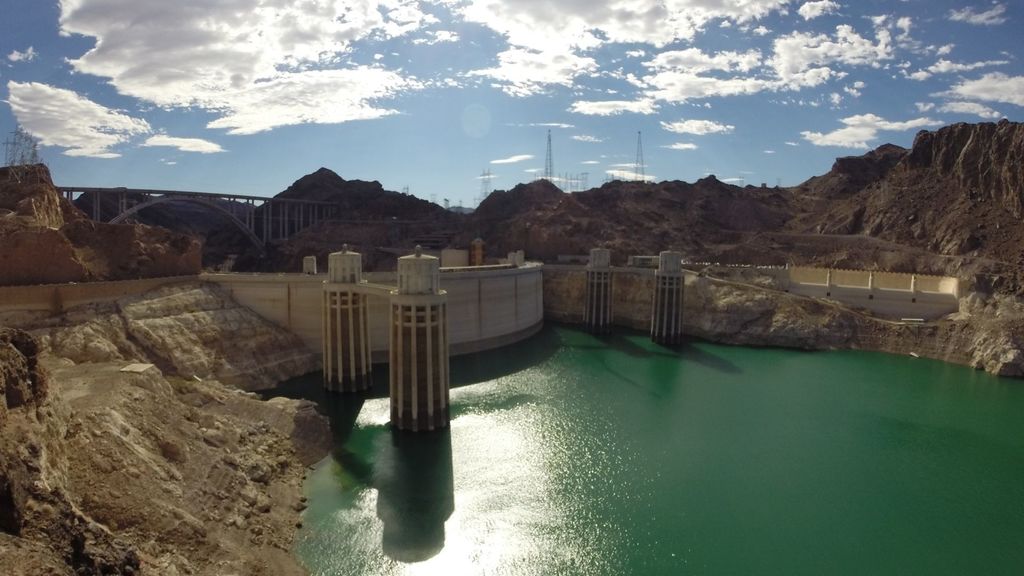
One of humanity's most ambitious projects is the Hoover Dam. Its height is 726 feet, and it stretches the Colorado River between Nevada and Arizona. Plus, the sparkling lights of Las Vegas are just a hop, skip, and a jump away.
The Hoover Dam auditorium and Visitor Center provide educational opportunities for all those interested in learning more about how the dam was constructed over four years during the Great Depression.
Don't skip a tour of the historic Hoover Dam Power Plant, which offers a fascinating look inside some incredible architecture and engineering. During the Powerplant Tour, you'll see audio and film presentations and exhibits, then be guided into the area that keeps the dam running.
For a 30-minute tour inside the plant, you'll travel an elevator 530 feet down via the Black Canyon. Another elevator journey will take you to the balcony, where you can enjoy a panoramic view of the facility and its eight massive generators.
Take the stairs or elevator adjacent to the Exhibit Gallery entrance to reach the Observation Deck atop the Visitor Center. Don’t miss out the panoramic views of Lake Mead, the Colorado River, and the dam are available from both open and sheltered areas while listening to an audio presentation detailing facts about the dam and its surroundings.
If that’s not enough, take a tour of Lake Mead, the Colorado River, and the Mike O'Callaghan-Pat Tillman Memorial Bridge for a closer breathtaking view. If you'd like to launch a canoe, kayak, or raft just below Hoover Dam on the Colorado River, you'll need to contact a livery service to deliver your craft.
Best time to visit: Throughout the year, this site may be crowded with visitors. However, tours are least busy between 9 to 10:30 AM., as well as 3:00 to 3:45 PM. Tourists that come before 2:00 PM will be able to enjoy the whole sight. The dam closes at 9 PM.
Driving distance and time: The distance is 37 miles, and the drive time from Las Vegas is 42 minutes.
4. Lake Mead
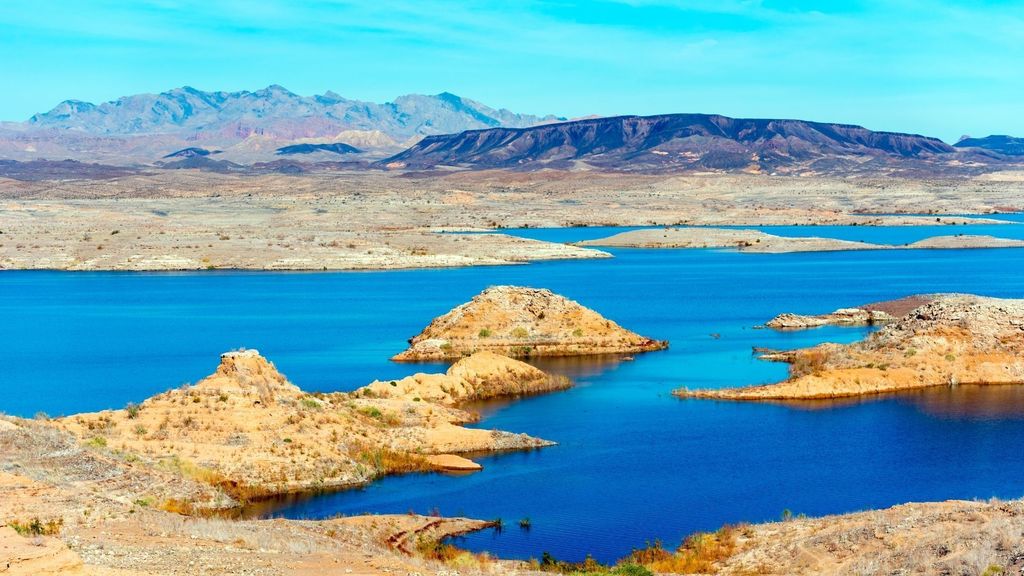
Lake Mead is the largest manmade reservoir in the United States, with a length of over 110 miles. It is situated on the Colorado River, about 25 miles southeast of Las Vegas, in both Nevada and Arizona. When Lake Mead is at its largest, it has 759 miles of shoreline, is 532 feet deep, has a land area of 247 square miles, and a total water volume of 28 million acre-feet.
Across this gorgeous area sits the Mojave Desert, which makes up 87% of the park and gives you an abundance of activities to experience and enjoy. So, if you're looking for some waterfront entertainment, Lake Mead is the place to be.
Take a 90-minute Desert Princess Cruise through Boulder Rocks and through the beginning of Black Canyon, all the way to Hoover Dam's brink.
Alternatively, take a high-speed boat ride or a 34-mile bike trip around the River Mountains Loop before cooling off in one of the swimming sites.
If you want someone else to show you around the lake, there are various guided tours available. Simply relax and enjoy the amazing vistas of this desert paradise.
Take an afternoon drive to experience the beautiful scenery of Lake Mead's Northshore Drive, which is one of the top land-based activities to do at Lake Mead.
Best time to visit: The months of October and November are thought to be ideal for visiting Lake Mead. By then, the summer heat has disappeared, and the cooler fall season has arrived. Winds are usually light and pleasant.
Driving distance and time: The distance is 27 miles, and it takes 33 minutes to drive from Las Vegas.
5. Grand Canyon
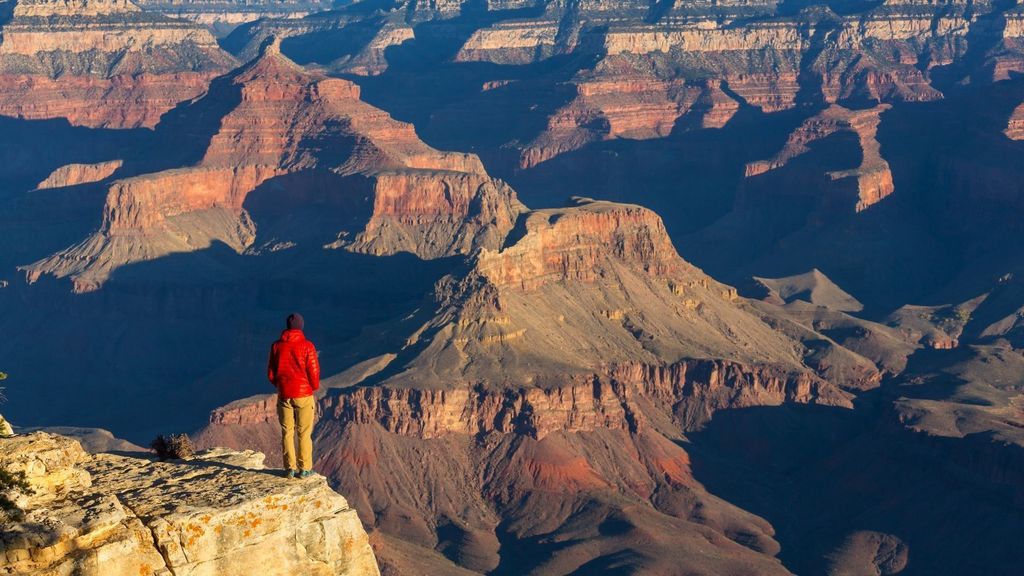
Northern Arizona's Grand Canyon, one of the Seven Natural Wonders of the World, brings Mother Nature's grandeur into perspective and acts as a glimpse into the region's geological and cultural history.
Consider the Grand Canyon's age: it's believed to be between 5 and 6 million years old. It has been continuously occupied since archaeologists discovered artifacts dating back to the Paleo-Indian period, 12,000 years ago. The mile-deep Grand Canyon is a sight to behold, with its vibrant and breathtaking colors. The canyon stretches for 277 river miles and has a range ranging from 600 feet to 18 miles. The Grand Canyon is kept grand by a dry environment that prevents the gorge from widening and leading to its incredible depths.
Grand Canyon Village is the park's most popular entrance point, and as a result, it frequently sees massive gatherings throughout the high seasons of spring, summer, and fall. Yavapai Point, one of the best vantage points for viewing the canyon, is located here. If you don't want to camp but yet want to stay within the park, this is the place to go.
Havasu Falls is a desert oasis with crystal blue streams and flowing falls that impart an almost dreamlike appearance to the dry canyon backdrop, and is hailed by visitors as one of the most magnificent sites in the Grand Canyon.
With the installation of the Skywalk at Eagle Point in 2007, the view grew much greater. Looking down, you can see right through the glass platform 4,000 feet to the Canyon floor below.
The Grand Canyon is divided into two rims: the North Rim and the South Rim. One of the finest ways to see the South Rim's most popular sights and perspectives is to hike the South Rim Trail, which is one of the Grand Canyon's most popular and extensive paths. This relatively easy walking path along the rim of the canyon, pauses at popular viewpoint locations such as Maricopa Point and Hopi Point.
The South Rim is accessible all year and offers camping and accommodations.
The North Rim is less well-known due to its steep, lonely paths, minimal facilities, and lack of attraction in the perspective of the tourist mainstream, but it is nevertheless worth visiting.
There are no transportation services over 8,000 feet, therefore the only way to get around is via car. The North Rim is only open to visitors from May to October due to its remote position when weather conditions make travel dangerous.
Best time to visit: The perfect time to travel to the Grand Canyon are March through May and September through November when daytime temperatures are cool, and the crowds are thin.
Driving distance and time: The distance is 126 miles, and it takes around 2 hours and 15 minutes to drive from Las Vegas to the West Rim.
6. Death Valley
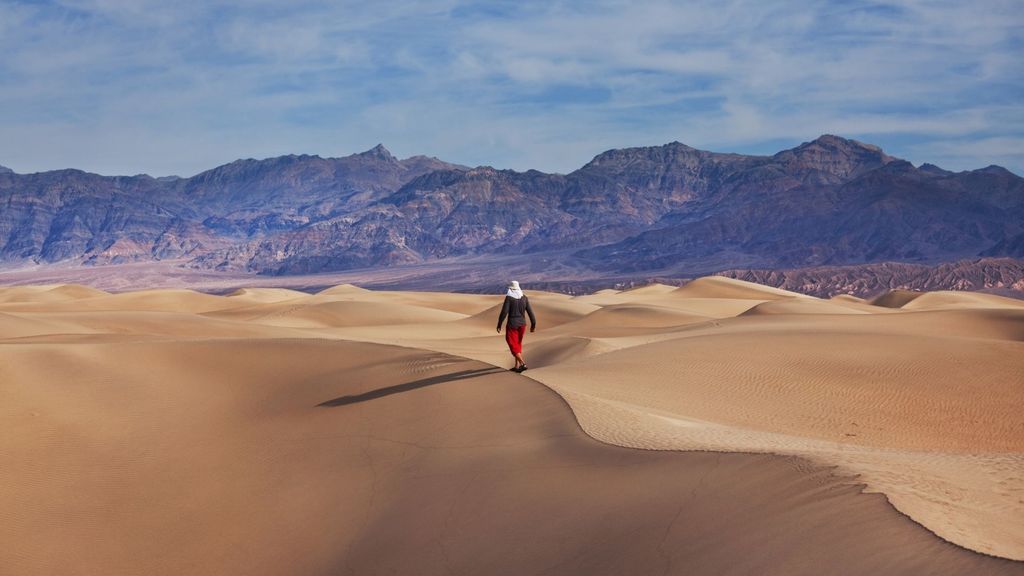
Death Valley is a place of extremes since it is the hottest, driest, and lowest national park in the United States. Death Valley is more than just a scorching desert; it has a startling contrast of landscapes to discover, from the snow that blankets the park's towering peaks to the lush wildflower meadows and small oases that provide respite from the heat to nearly endless desert plains.
When hiking the miles of trail or sitting and enjoying the blooming desert wildflowers in the spring, keep an eye out for coyotes, bighorn sheep, or foxes, as this national park is teeming with life and entertainment. You can even take your pet on a leash for a walk down the scenic roads with you.
The Mesquite Flat Sand Dunes, located just east of Stovepipe Wells, are one of Death Valley's most picturesque and photographed sceneries. The views are spectacular in the morning and late afternoon when the sun hits the sculpted dunes, casting long curving shadows. You may take a stroll across the dunes, climb to the highest spots, or relax in a lawn chair and take in the views.
Badwater Basin, located near the southern end of Death Valley National Park, is the lowest point of land in the western hemisphere, measuring 277 feet below sea level.
Badwater Lake is a tiny lake surrounded by mountains with a salt rim, however, there isn't always water here. Badwater may be quite full or have very little water depending on the conditions or the time of year. When there is almost no visible water from the coast, you can walk out across the white salt flat for what seems like an eternity. When there is water and the air is still, as it often is in the morning and early evening, the mountains across the valley are reflected in the water, creating a breathtaking view.
With a four-wheel-drive car, you may travel down a rough road to The Racetrack, one of Death Valley's most intriguing sites. This place is a large dried mud bed with stones of all sizes and long paths following behind them, as though driven through the mud.
Dante's View provides one of the most panoramic views of Death Valley. The view from the top views out over the valley floor as far as the eye can see, as well as over the valley to the mountains on the other side.
Best time to visit: The best time to visit Death Valley is in the spring when the wildflowers are in bloom, or in the autumn when the skies are clear. The weather is good in both seasons. Although the winter months are cooler, they are nonetheless pleasant in terms of weather and are less congested. It gets really hot in the summer.
Driving distance and time: The distance is 131 miles, and it takes around 2 hours and 17 minutes to drive from Las Vegas.
7. Zion National Park
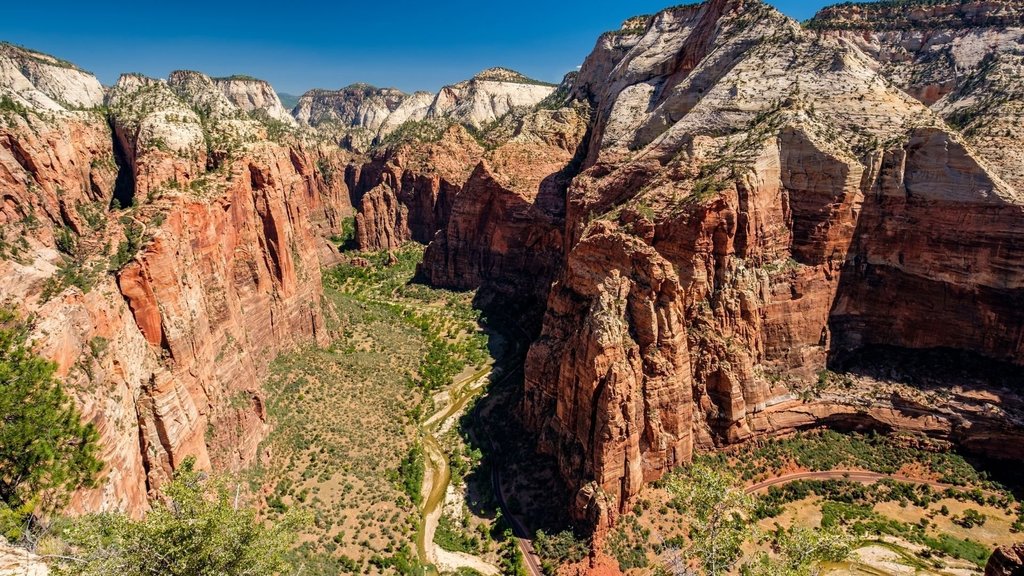
Zion National Park, in southwestern Utah's Washington, Iron, and Kane Counties, encompasses some of the country's most scenic canyon country. High plateaus, a labyrinth of narrow, deep sandstone canyons, and the Virgin River and its tributaries are all found within its 232 square miles. 2,000-foot Navajo Sandstone cliffs, pine- and juniper-clad hills, and seeps, streams, and waterfalls supporting lush and vibrant hanging gardens are also found in Zion.
The varied topography of Zion contributes to a wide range of ecosystems and wildlife. The richness of Zion's ecosystems includes desert, riparian (riverbank), pinyon-juniper, and conifer woodland populations.
The Mojave Desert, the Great Basin, and the Rocky Mountains are all nearby habitats that contribute to Zion's abundance. There are over 1,000 plant species, 78 mammal species, 30 reptile species, 7 amphibian species, 8 fish species, and 291 bird species in the park.
The most dramatic section of Zion National Park is Zion Canyon. The Zion Canyon Scenic Drive, an in-and-out route that runs down the canyon floor with high sheer walls on both sides, is the only way to get into the canyon. This route provides views of some of the park's most well-known attractions, including a lookup to Angels Landing. The road comes to an end at the start of the Narrows, one of the park's most famous attractions. The park's shuttle bus, which stops at picturesque locations and hiking trailheads along the way, is a convenient method to go about this area.
The Zion-Mount Carmel Highway, which runs from the South Entrance to the East, is perhaps as beautiful as the Zion Canyon Scenic Drive, but it offers a completely different perspective as it winds high above the valley providing stunning vistas from one side to the other. As it rises up the hillside, the road follows the rock wall. The road runs via a narrow 1.1-mile tunnel after a steep ascent. Because the tunnel is too narrow for RVs to pass through, traffic is diverted in one way when RVs enter the tunnel. To pass through the tunnel, RV drivers must pay a fee when they enter the park.
Hikes ranging in duration from less than a mile to multi-day expeditions are available in Zion National Park. Angels Landing and The Narrows are two of the park's most well-known trails.
Angels Landing is a hard hike that leads to a breathtaking perspective of Zion Canyon. The trail traverses a narrow ridge with considerable drop-offs and is not recommended for everyone, especially those who are afraid of heights. In contrast, The Narrows follows a river through a massive slot canyon. If you want to do this hike, you'll need to plan ahead of time.
Weeping Rock is a popular stop along the Zion Canyon Scenic Drive. The hanging gardens that cling to the otherwise vertical cliff side can be seen up close from this dripping stone overhang. The amount of water coming from the rock varies depending on the season and can be drips, a stream, or a full waterfall. Standing at the base of Weeping Rock provides a unique viewpoint of the valley and a true sense of the canyon walls' immensity.
Best time to visit: The greatest time to visit Zion is in the spring and fall when the weather is milder.
Driving distance and time: The distance is 160 miles, and it takes around 2 hours and 36 minutes to drive from Las Vegas.
8. Antelope Canyon, Page, Arizona
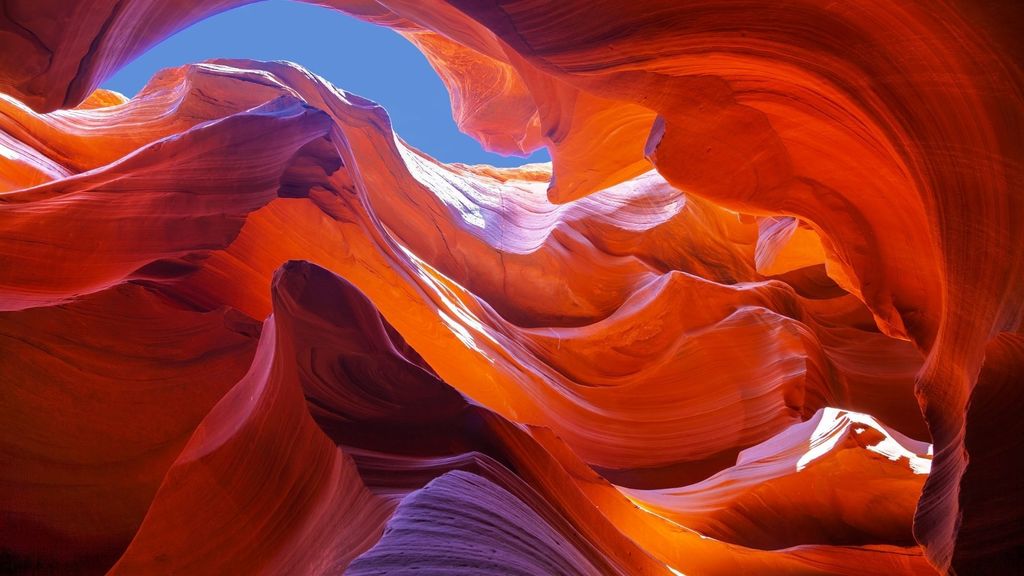
Antelope Canyon is a majestic slot canyon in Northern Arizona, located just east of Page.
Antelope Canyon, in reality, is a complex, multi-faceted eco-system with multiple drainages that funnel water into what is now Lake Powell. It's a massive sandstone sculpture with tall winding walls.
The canyon is a photographer's dream, with its wave-like structure and light beams that shine directly down into the canyon's openings, making it a supernatural look. Antelope Canyon is also an example of a geological oddity known as a "slot canyon," which is formed when water finds its way through a crack or fissure in the bedrock and forms a small canyon.
It is prohibited to enter Antelope Canyon without first booking a guided excursion with one of the three major outfitters in Page or a Las Vegas outfitter. To visit Upper or Lower Antelope Canyon, you'll need to make a reservation with a Navajo guide ahead of time. Before you go, make a reservation online because tours might sell out weeks in advance.
The majority of Upper Antelope Canyon 90-minute excursions cost between $50 and $90 (slightly less for children), while some operators offer early bird and last-minute discounts. Lower Antelope Canyon excursions last an hour and cost $40, with premium options costing up to $80.
Best time to visit: Antelope Canyon is open throughout the year; however, most visitors prefer to visit during the day on weekends between March and October, when the light shafts occur. The crowds will be at their greatest, making it tough to capture that perfect photo.
Driving distance and time: The distance is 277 miles, and the drive time from Las Vegas is around 4.5 hours.
9. Bryce Canyon National Park
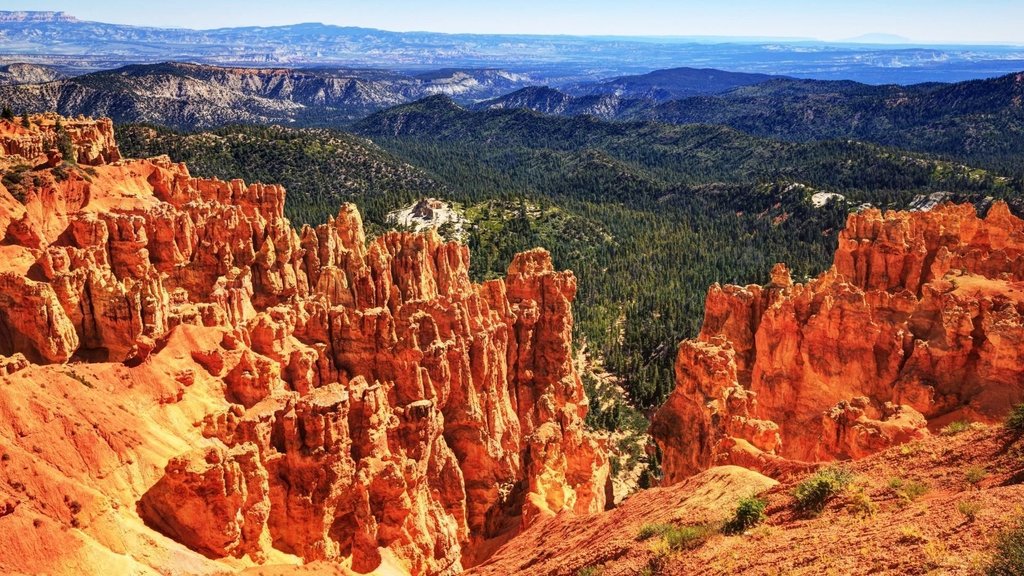
Bryce Canyon National Park, a sprawling reserve in southern Utah, is known for crimson-colored hoodoos, which are spire-shaped rock formations. The sandstone cliffs of Bryce Canyon National Park have been eroded into otherworldly characters plucked from the unconscious of a crazy Viking by wind, water, and time. Rows of humanoid pillars, crosshatched by rock strata, seem almost deliberate but are completely unreal. So quiet, creepy, and lovely.
Bryce Canyon is a great destination for any type of visitor. Outdoor enthusiasts can get all of the hiking and backcountry exploring that they want. People who prefer relaxing in nature appreciate the quiet setting and beautiful scenery. Photographers love the breathtaking views of the unique landscape. Bryce Canyon has something for everyone, all year round.
Inspiration Point, which has three levels of viewpoints, offers a variety of views of the main amphitheater. Visitors may see the Silent City (near Sunset Point), which has rows of hoodoos set against the backdrop of Boat Mesa, from here. The view has been described as "one of the most spectacular views in the United States" by recent visitors, who also highlighted that it is a perfect method for persons with mobility challenges to experience "one of the most spectacular views in the United States."
Bryce Point, one of the park's most popular viewpoints, offers spectacular sunrises for those willing to wake up early. The tops of the hoodoos appear to be on fire as the sun rises, and then they change colors quickly and almost magically. Former visitors who went early in the morning described it as "breathtaking," but others said it is beautiful at any time of day.
This picturesque site not only provides breathtaking vistas but also some of the park's more imaginatively named formations. The Boat Mesa and the Sinking Ship, which are placed against the Pink Cliffs of the Aquarius Plateau, are visible to visitors. Boat Mesa rises to 8,073 feet above the hoodoos of Fairyland Canyon and is crowned by the refractory granite known as "The Conglomerate at Boat Mesa." Don't worry; once you see the formations, these names make sense.
Rainbow Point, located at the park's southern extremity, provides panoramic views of the entire park to the north. Yovimpa Point, which is also here, is where you can see the Grand Staircase, which is a series of granite layers. Each layer has a different hue and is labeled accordingly.
Best time to visit: The best time to visit Bryce National Park is May through September. This time of year not only brings the warmest weather, but it also brings a plethora of ranger activities.
Driving distance and time: The distance is 260 miles, and it takes around 4 hours to drive from Las Vegas.
10. Seven Magic Mountains
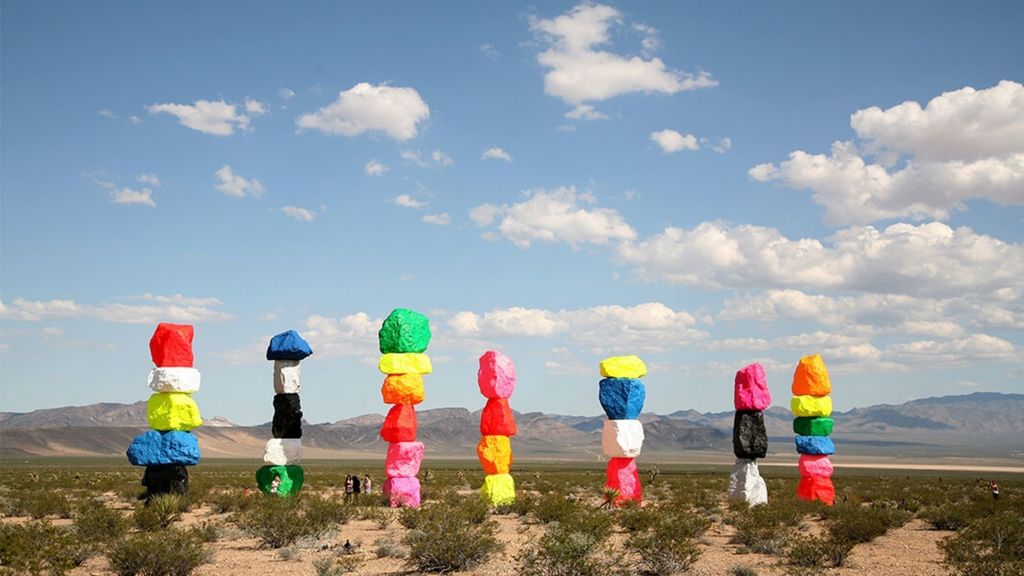
Seven Magic Mountains, located in the Nevada desert, are described as "seven towers of colorful, stacked boulders standing more than thirty feet high."
When Swiss artist Ugo Rondinone unveiled his one-of-a-kind, large-scale public art installation in the desert outside of Las Vegas in 2016 for a two-year period, he had no idea what would follow. According to Rondinone, the venue is physically and symbolically mid-way between the natural and the artificial: the natural is expressed by the mountain ranges, desert, and Jean Dry Lake backdrop, while the artificial is expressed by the highway and the steady flow of traffic between Los Angeles and Las Vegas.
Best time to visit: The Seven Magic Mountains is a great destination any time of year.
Driving distance and time: The distance is 27 miles, and the drive time from Las Vegas is around 33 minutes.
11. Mount Charleston
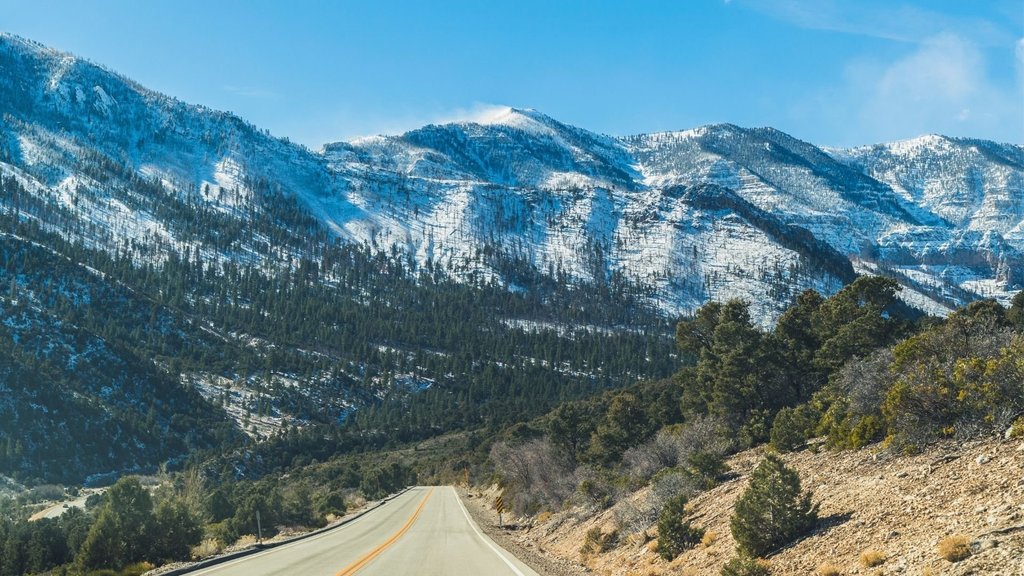
Is there snow? Are you in Las Vegas? It's impossible! It isn't, though. The Mt. Charleston Wilderness, just 39 miles from Las Vegas, is an exciting place with invigorating mountain air, ice-cold springs, and acres of noble evergreen woods, making it a perfect day trip.
Towering crags, deep and broad canyons, narrow slot canyons, and steep hillsides make up the rugged mountain scenery that spreads across the crest of the Spring Mountains.
The Mt. Charleston Wilderness contains the intermountain ecoregion's largest stand of bristlecone pine (Pinus longaeva). These trees are prized for their aesthetic and scientific merit, and they are among the world's oldest living species.
Skiing, snowboarding, sledding, and tubing are all available to visitors of all ages.
Hiking is another popular Mount Charleston activity, especially in the middle of the winter. The Shady Hollow Trail, Step Ladder Trail, and Showgirl Trail are among the best. When trekking in the winter, dress in layers to be warm without being hot.
Many of the trails are also suitable for biking if you prefer to explore the mountain on two wheels. Stop for lunch at the Kyle Canyon Picnic Area after hiking the gorgeous Cliff Rose Rim Trail or the strenuous Acastus Trail.
On horseback, visitors of all levels can enjoy the area. There are a number of horseback riding trails as well as guided trips for people of all ages. Take on a trail ride at the Mount Charleston Riding Stable, which offers rides of varying lengths.
Best time to visit: Summer is the best time to hike Mount Charleston because the rest of Las Vegas is too hot for outdoor activities; however, July and August are also part of the region's "monsoon season," which means some campgrounds may be closed due to increased rain.
Driving distance and time: The distance is 39 miles, and the drive time from Las Vegas is around 46 minutes.
12. Area 51
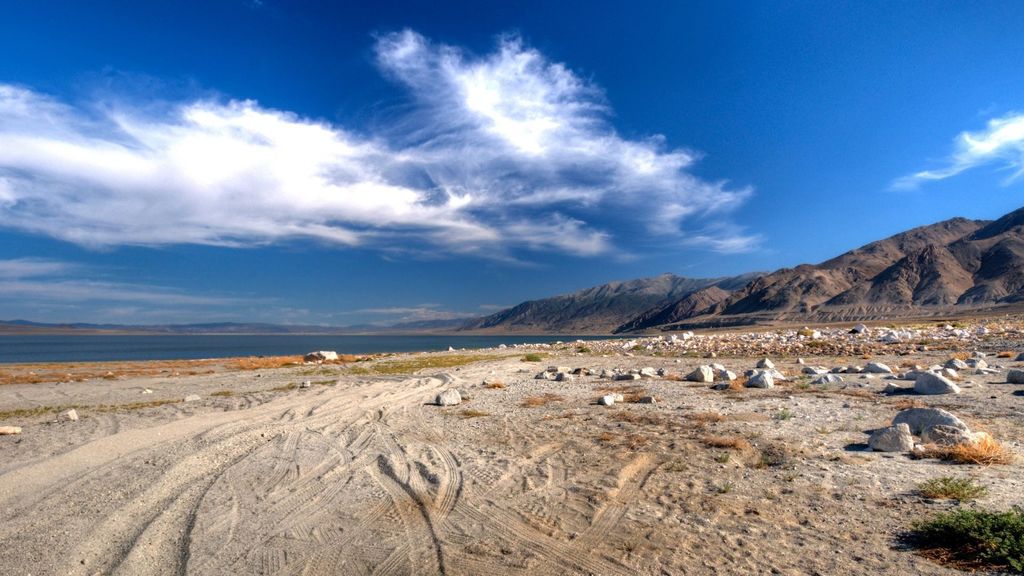
Groom Lake in southern Nevada is home to Area 51, a top-secret US Air Force military base.
For decades, the Area 51 Air Force base in Nevada has been at the center of a conspiratorial storm centered on "proof" that aliens (and their technology) live and are hidden behind its walls.
Books, TV shows, and even huge online "raids" have attempted to see past its ominous warning signs. While you can't visit Area 51 since it's a closed military base and all, you can get pretty nearby.
While some aspects of Area 51's grandeur are best left to the imagination, it's nevertheless fascinating to go out and get close to a top-secret military base that everyone knows about.
Walking up to the rear gate and Groom Lake Road gate will give you a great sense of accomplishment. The white truck up on the hill to the right just before the gate, where the road dips down and turns to the gate, is also interesting to watch. You may be aware that you're being watched, and the white truck is the object of their attention. Without a doubt, they are being watched as soon as they approach the Extraterrestrial Highway. A gentle buzz can be heard at the Groom Lake Road entrance. Strong enough to be heard even when the wind is blowing. It is done to add to the appeal of mystery.
Best time to visit: Area 51 is a great destination any time of year
Driving distance and time: The distance is 147 miles, and it takes around 2 hours and 15 minutes to drive from Las Vegas.
13. Mojave National Preserve
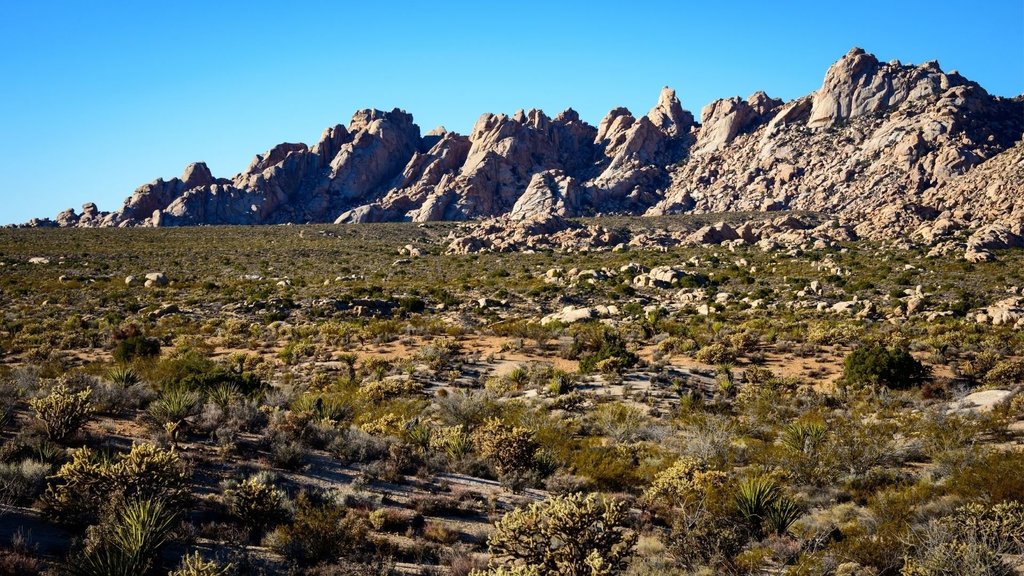
Mojave National Preserve will open your eyes to never-ending beauty from singing sand dunes, cinder cone volcanoes, a vast Joshua tree forest, and carpets of spring wildflowers are all found within this 1.6-million-acre park, situated halfway between Los Angeles and Las Vegas.
Long-abandoned mines, homesteads, and rock-walled military outposts can be found in its canyons, mountains, and mesas.
Start your visit at the preserve's excellent visitor center, which is housed in the historic Kelso Depot, a 1924 Spanish Mission Revival style railroad stop. After picking up maps and information, take a look at the highlights of the preserve. The nearby Kelso Dunes, California's second-largest dune system, is the most iconic sunset and sunrise site.
Kelso Depot is now a museum, complete with a 20-minute video and an information center. A good, quick pit stop when in the park, as well as a wonderful location for maps and restrooms.
Teutonia Peak is a 4-mile round trip hike that leads to the top of a tiny peak with a lot of prominences. You can see the Cima Dome from here, walk through the largest Joshua Tree forest in the world, and explore a number of old abandoned mines.
Best time to visit: February and April, when temperatures are pleasant and wildflowers are in bloom, is the best time to visit. The months of October and November provide pleasant weather and little visitors.
Driving distance and time: The distance is 67 miles, and the drive time from Las Vegas is around 1 hour.
14. Cathedral Gorge State Park

Cathedral Gorge State Park is in southeastern Nevada, in a long, narrow valley where erosion has developed dramatic and unusual patterns in the soft bentonite clay.
The park's beauty begins with an explosive volcanic activity that deposits layers of ash hundreds of feet thick with each eruption.
There are numerous walking trails to explore the cave-like formations and cathedral-like spires formed by geologic processes that occurred millions of years ago. The park is a photographer's dream, with breathtaking views of the scenic canyon and opportunities for hiking, picnicking, camping, and nature research.
Visit the visitor center to learn more about the park and create a game plan for your visit. The best portions of the park are always known by the rangers.
Undertake the Miller Point Trail if you only do one hike in the park. This 2-mile out-and-back trip takes you through a canyon and begins at the Caves Area parking area. There is a big steel staircase toward the end that leads to a magnificent view.
Best time to visit: The best times to visit are in the spring and fall. You can also visit in the winter; however, the days are shorter and road conditions are more challenging.
Driving distance and time: The distance is 166 miles, and the drive time from Las Vegas is around 2.5 hours.
15. Dixie National Forest
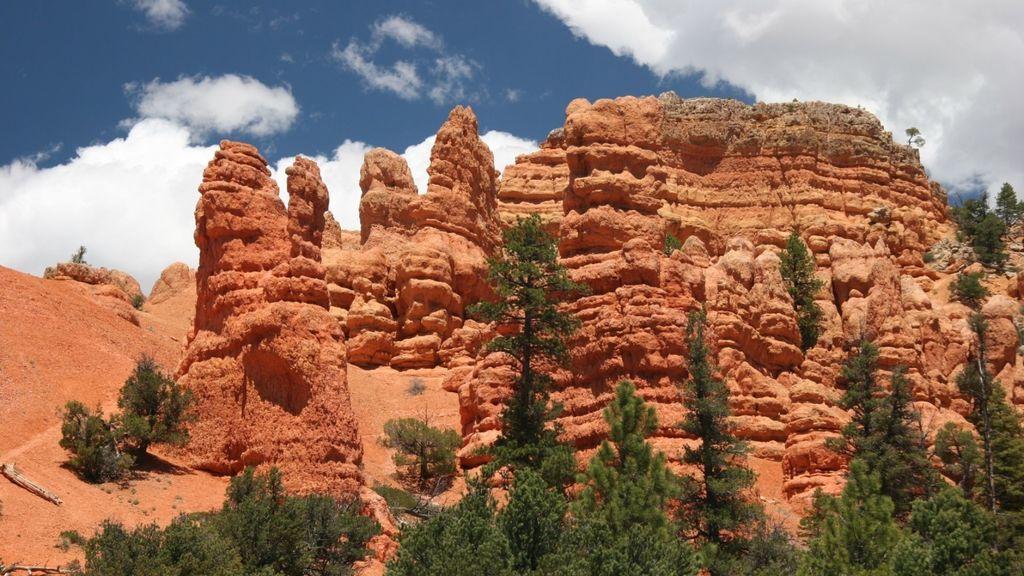
The Dixie National Forest is a 170-mile strip of land in southern Utah. In the heart of the Dixie Forest is Red Canyon, one of the most beautiful colored cliff canyons in southern Utah.
Visitors can drive through the canyon or hike one of the canyon's nature trails to see the canyon's bright red spires and cliffs. Weather-sculpted formations of limestone are contrasted by giant ponderosa pines. A walk in Pine Valley, a visit to scenic Navajo Lake, fishing at Panguitch Lake, touring the east fork of the Sevier River, or traveling the scenic Boulder/Grover Road on Boulder Mountain are all within a day's drive. Camping is available in all regions.
Camp in the Dixie National Forest so that you may fully involve yourself in nature. Both solo and group travelers will enjoy camping in Dixie.
The brilliant blue water of Navajo Lake complements the gorgeous mountain surroundings. The lake is not visible from the campground, although it is only a short drive away. The Navajo Lake Loop Trail is a 10-mile hike that takes you around the entire lake.
The trailhead is located at the top of Te-Ah Campground and is an approximately 1-mile round trip. It begins with a gentle climb and becomes more difficult towards the conclusion with a steeper gradient. You emerge from the trees at the trail's end and step onto a little precipice. From here, you can see amazing rock formations while looking down into the deep forest below.
Best time to visit: Dixie National Forest is a great place to visit during the summer. You're away from the scorching heat at high elevations, yet the forest is lovely in the winter! Many regions provide opportunities for winter sports such as cross-country skiing and snowmobiling.
Driving distance and time: The distance is 182 miles, and it takes around 2 hours and 45 minutes to drive from Las Vegas.
16. Goodsprings Ghost Town
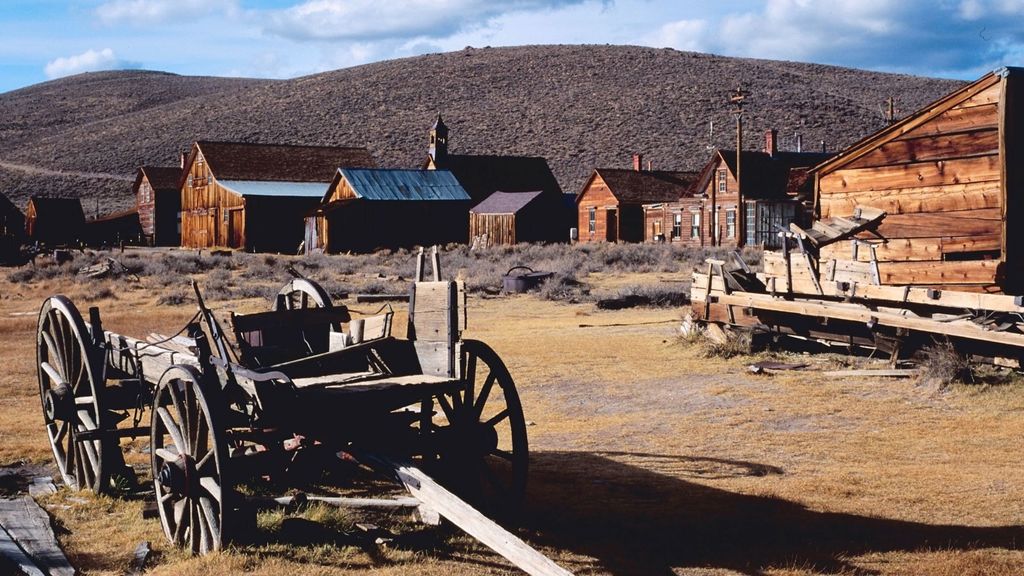
There's no better way to peel back the pages of time than visiting Goodsprings Ghost Town if you're in the Las Vegas area and looking for an authentic Wild West ghost town day trip.
Visitors can know about the popular Pioneer Saloon, adrenaline-pumping off-road tours, storied Hollywood history, and what was once one of the most prosperous mining districts in southern Nevada at this frozen-in-time Nevada ghost town.
Outfitted with original wooden boardwalks out front, the Goodsprings Pioneer Saloon is a stamped tin manufactured building made by Sears and Roebuck. It’s believed to be one of the last—if not the very last—of its kind in the United States.
Carole Lombard was completing a war bond rally and flying from Indiana to Los Angeles when her jet tragically crashed into Mt. Potosi, about 11 miles from Goodsprings, after refueling in Las Vegas. Clark Gable, Lombard's husband, waited days at the Goodsprings Pioneer Saloon for her search party to return. Cigarette burns on the Brunswick bar counter are testimony of his visit, as he nodded off while waiting for news of Lombard's tragic death.
Best time to visit: Goodsprings Ghost Town is a great destination any time of year.
Driving distance and time: The distance is 38 miles, and it takes around 45 minutes to drive from Las Vegas.
17. Techatticup Mine, Nelson, Nevada

The Techatticup Mine, located in the arid Nevada hills, used to produce enough gold and silver to inspire murder, deceit, and claim to jump. It has now been partly restored and is open to tourists who want to take a walk through the rugged yet thankfully bloodless tunnels.
Although Spanish explorers found dense veins of precious metals in the hills of what is now Nelson, digging did not begin in earnest until about a century later, resulting in one of the state's largest mining booms. Around the mid-1800s, hungry prospectors flocked to the town, digging a network of tunnels and shafts deep into the hills, pursuing seemingly endless mineral veins into the earth.
The Techatticup Mine was eventually abandoned once the boom ended, leaving behind kilometers of tunnels and innumerable dilapidated sheds and homes.
The Werly family purchased the estate after decades of neglect and began to work renovating the old structures and even excavating and investigating the many tunnels. The Werlys now provide historic tours of parts of the mines, walking guests 500 feet into the hills over holes hundreds of feet deep and exposing veins of gold and silver that are still unmined in the rock.
Best time to visit: The Techatticup Mine is a great destination any time of year.
Driving distance and time: The distance is 45 miles, and it takes around 51 minutes to drive from Las Vegas.
18. Lost City Museum
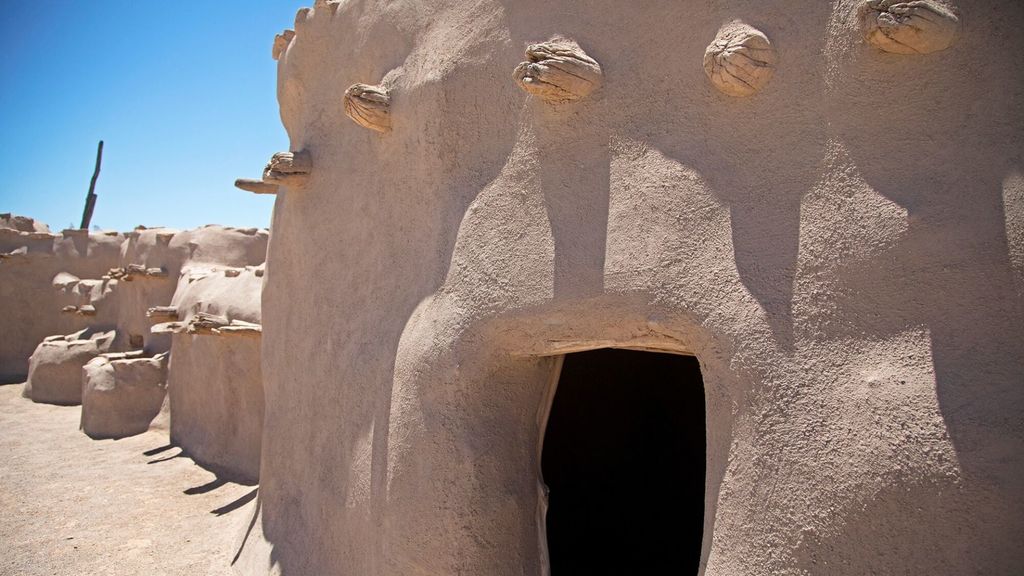
The Lost City Museum, formerly known as the Boulder Dam Park Museum, was founded by Civilian Conservation Corps members in 1935. If it's not pool season, this is a fun little side trip to take when visiting Las Vegas. Although the museum is tiny, the drive along Moapa Valley Blvd is breathtaking.
The museum was founded by the National Park Service to house artifacts recovered from prehistoric archaeological sites in the region, the majority of which were flooded when the Colorado River was dammed to form Lake Mead.
What they discovered and the story it tells about the culture that once existed in the region is fascinating. It also describes the animals that lived in this region many years ago, as well as the fossils they discovered.
There are two short films to watch at the museum, and replicas of real-life buildings can be found outside. Parking is plentiful, even for large vehicles. There are restrooms and a gift shop on site.
Best time to visit: The Lost City Museum is a great destination any time of year.
Driving distance and time: The distance is 65 miles, and the drive time from Las Vegas is around 1 hour.
19 . Sloan Canyon National Conservation Area
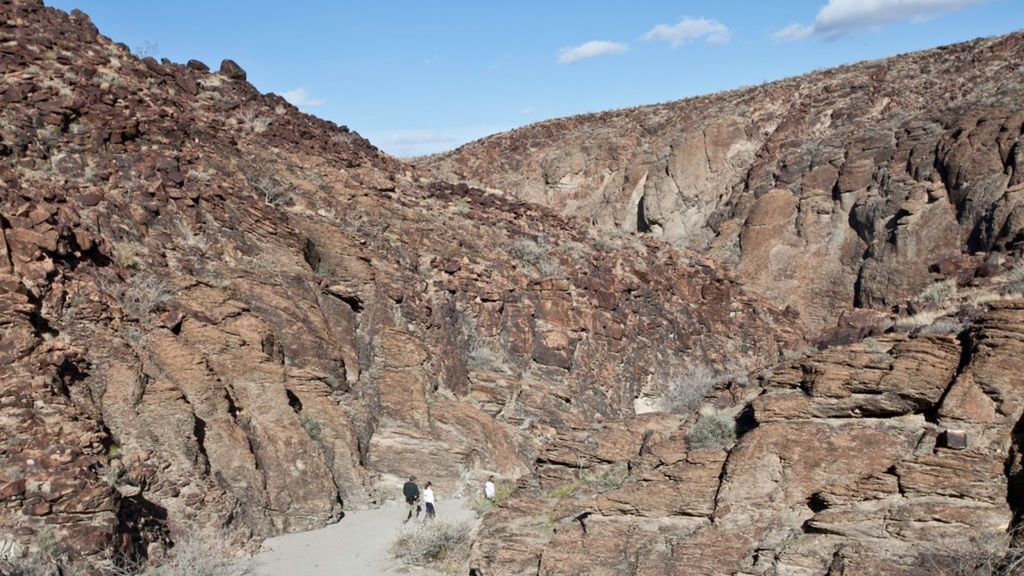
The 48,438 acres of Sloan Canyon National Conservation Area offer quiet and tranquility to visitors who come to see the area's distinctive visual and natural features, as well as its exceptional cultural heritage.
The Sloan Canyon Petroglyph Site, one of Southern Nevada's most important cultural resources, is the area's focal point. Archaeologists estimate that native tribes from the Archaic to Historic Period constructed more than 300 rock art panels with 1,700 distinct design components.
Sloan Canyon is one of Southern Nevada's most important rock art locations. Please do not touch the rock art to preserve the petroglyphs because contact with the oils in your skin will harm them. Photographs and sketches are acceptable, but rubbings are not. Climbing near rock art should be avoided.
At Sloan Canyon, you'll have endless opportunities to see animals, making for an amazing day.
Jackrabbit, Desert Kangaroo Rat, Desert Tortoise, Chuckwalla, Coyote, Kit Fox, Roadrunner, Desert Bighorn Sheep, Bobcat, Mountain Lion, Quail, and a few bats are among the mammals, reptiles, and birds that make the area home.
The North McCullough Wilderness lies adjacent to the Sloan Canyon National Conservation Area, and the restrictions that apply here are the same as those that apply to all congressionally designated wilderness areas.
Hiking, horseback riding, and animal watching are welcomed. Within the wilderness boundaries, all vehicles, including mountain bikes, are prohibited. In the Sloan Canyon Petroglyph Area, only hiking is permitted.
Best time to visit: Best time to visit in the winter months, when the weather is the most favorable for hiking. It can be a bit hot in the summer.
Driving distance and time: The distance is 17 miles, and the drive time from Las Vegas is 20 minutes.
20. Nellis Dunes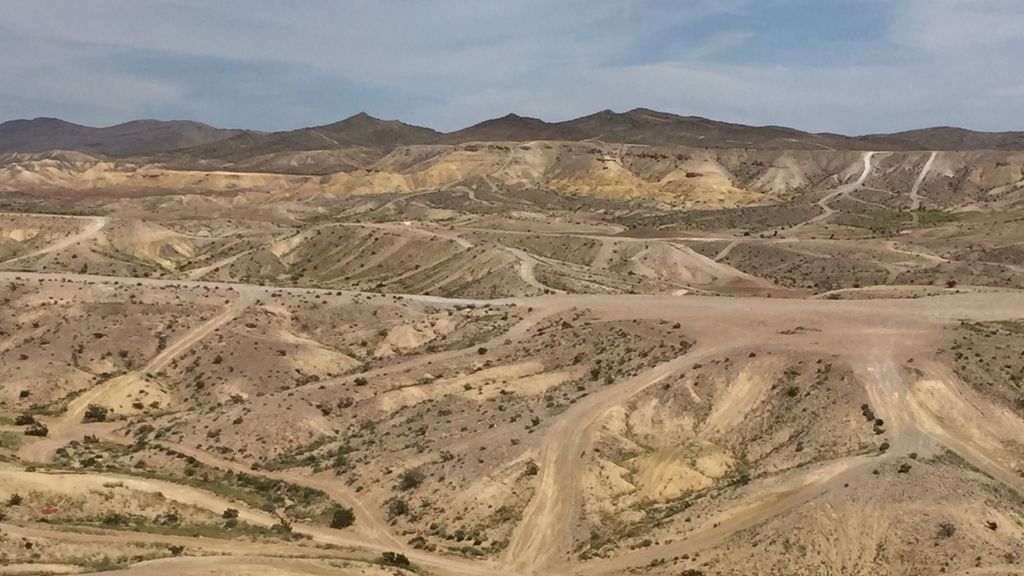
The Nellis Dunes Off-Highway Vehicle Area, located north of Las Vegas in Clark County, was established by Congress in 2014. The whole area is 10,035 acres, with over 900 acres set aside for the OHV Park by Clark County.
Competitive race events, training, and other recreational activities are organized in the area. This location is conveniently located near Las Vegas.
The ATV Nellis Dunes Tour in Las Vegas is guaranteed to be an adrenaline-pumping adventure that you and your friends will never forget. The undulating Nellis Dunes are just minutes away from the Las Vegas Strip, and the Las Vegas Valley is famed for its desert topography.
While the Las Vegas ATVs Nellis Dunes tour is a tourist favorite due to the thrilling terrain and close proximity to the Las Vegas Strip, many ATV tour companies provide a number of alternative excursions from which you can choose for a safe and inexpensive tour.
You and your family can take a ride through the Mojave Desert to see the natural side of Las Vegas, which includes mountains.
An ATV excursion can cost $99 for one person and $189 for two people.
Best time to visit: The Nellis Dunes is a great destination any time of year
Driving distance and time: The distance is 20 miles and it takes 33 minutes to drive from Las Vegas.
There is so much more to see and do in Southern Nevada than simply Las Vegas, no matter where you choose to spend your time. Get out of Las Vegas and see some of the finest Nevada has to offer, even if it's only for a day! Be sure to check out GAFFL to find a travel buddy in case you need someone to travel with.
Have more time? Check out these guides to learn more about other popular day trips in the United States!



















